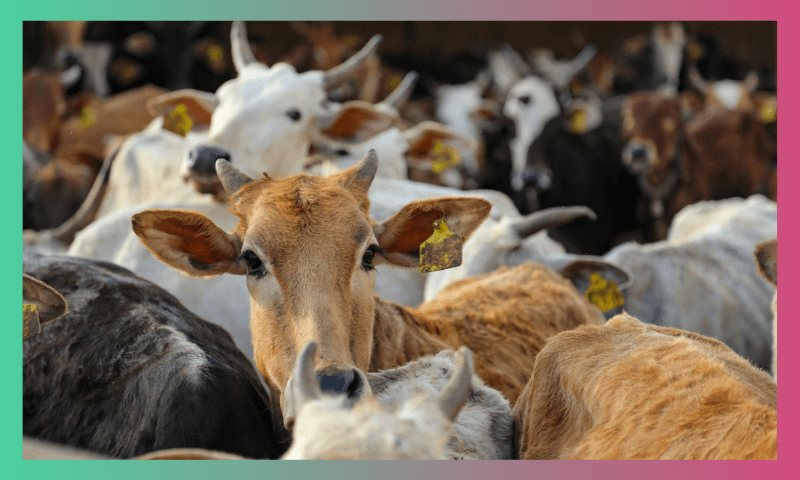Having spent a part of my childhood in a village, I saw cows being treated with status almost equal to that of a regular family member. In fact, a cow was held so high in respect that we even called them a family member— clean cow pens, proper nutrition and what not was given to a cow. A calf being born was one of the most joyous days.
Now, with the passage of time, a cow is nothing more than an exploitable asset for the
industries.
Gone are the glorious days when cows were members of the family, and we now witness the dawn of the dystopian era where cows live their worst lives possible.
Chronologically speaking, a cow suffers its entire life, from being mishandled while being transported to being artificially inseminated and overbred and finally dying a not-so-peaceful death in the slaughterhouses. But that’s just the tip of the iceberg. What happens on a more grand scale is enough to shiver your timbers.
There’s much more harm being done to these cows, both mentally and physically.

History
Dairy farming in India increased in the 1920s when sophisticated milk processing and marketing technology were introduced. In 1969–70, the National Dairy Development Board (NDDB), established in 1965, started Operation Flood, a programme aimed at modernising and growing the dairy sector through co-operatives.
It helped India transition from a milk deficient country to the world’s most significant milk producer, overtaking the United States of America in 1998. In 2018, it accounted for around 22.29 per cent of worldwide output. Within 30 years, it has quadrupled the amount of milk accessible per person in India, making dairy farming the country’s most significant self-sustaining rural job generator. This went on to be called the White Revolution. Prime Minister Lal Bahadur Shastri named Dr Verghese Kurien, the chairman and founder of Amul, the Chairman of NDDB. Kurien was instrumental in the program’s success and is widely regarded as its architect.

Analysis
From mishandling their bodies to abusing their emotions, dairy farm’s got it all!
The dairy industry often tries to hide its dark deeds under the fact that it contributes more than 4% of India’s GDP. Usually, cows are kept in a tight space in these farms with little to no room available for their movement. There, they are fed hay and milked on a regular basis. A cow, on average, produces 50 lbs (or 22 KG) of milk a day. That number sounds so unreal, right? How do these industries squeeze out so much milk out of cows? Well, Cows naturally make only enough milk to meet the needs of their calves (approximately 16 lbs/7.25 KG a day). To pump up the numbers, industries use genetic manipulation, antibiotics, and bovine growth hormones (BGH) to force a cow to produce as much milk in a day as possible. The hormones adversely affect the cows’ health and increase the rate of congenital disabilities in their calves. BGH may also increase the risk of developing breast and prostate cancer in humans.
To keep producing milk for human consumption, a cow must have a calf each year, and in order to maintain a steady supply of milk, the cows are repeatedly impregnated. What happens to the calves? With the constant bombardment of the calf’s mother with hormones, the calf has a slight chance of being born with congenital disabilities. And if it is, it’s going straight to the slaughterhouse.
More than 30 cows and calves are stuffed into a transport vehicle (breaking the transportation rules) and sent to their demise, where they are not stunned before being butchered but skinned alive.
What do they need the skin for? They stuff it with hay and place it near the mother to trick the mother into producing more milk.
And if the calf is not born with a defect, it’ll be taken away from its mother within 12 to 24 hours, and the following will happen.
- If the calf is a male, they’re going to starve or they die during their initial stage of life.
- If the calf is a female, it’ll be raised to produce more milk for the industry, thus continuing the cycle.
The average lifespan of a cow is around 20 to 25 years and can produce milk for 8 to 9 years. But all this trauma put on a cow renders the cows worthless to the industries, thus sending them to the slaughterhouse at the age of around 4 to 5.

How does it affect you?
But the cows are not the only ones whose health is at stake. Yes, the commercial milk in your glass is not safe for you either!
According to the American Gastroenterological Association, cow’s milk is the leading source of food allergies in newborns and children.
Cutting down on your dairy consumption, on the other hand, will be more beneficial to you (despite popular belief)
A UK study showed that people who suffered from irregular heartbeats, asthma, headaches, fatigue and digestive problems showed marked and often complete improvements in their health after cutting milk out of their diets.
So the next time you’re enjoying your hot milk on a chilly winter morning, ask yourself one question, “is it worth it?”


5 Responses
Very insightful and well explained article, 10/10 😀
How do I like
❤❤❤❤❤❤❤
Very well written..with sharp observations and deeper analysis
Whoah dude this such a well crafted argument!
It has the power of, “grabbing a reader’s eyes”.
Cheers!!
😔gaiya rani